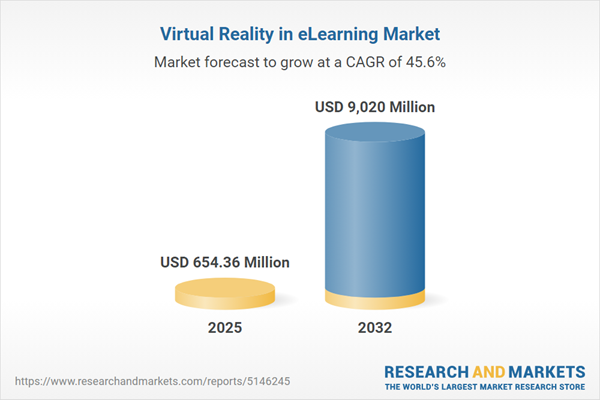Speak directly to the analyst to clarify any post sales queries you may have.
Virtual reality in eLearning is reshaping how enterprises approach training and workforce development. For senior decision-makers, this evolution offers scalable, immersive learning solutions that respond to the changing demands of digital work environments.
Market Snapshot: Virtual Reality in eLearning
The virtual reality in eLearning market is experiencing strong annual growth in market value, with adoption projected to accelerate from 2024 to 2032. Industries such as healthcare, finance, manufacturing, and education are at the leading edge, integrating VR to drive digital transformation, enhance onboarding, and deliver compliance-focused training. Organizations leverage virtual reality platforms to ensure consistent and reliable training for distributed and hybrid teams, regardless of location. As agile operations become standard, executive teams are using virtual reality to strengthen workforce readiness and respond to shifting competencies needed in evolving business environments.
Scope & Segmentation of Virtual Reality in eLearning
- End Users: Corporate organizations harness VR for leadership and technical skills training; defense and security apply simulation-based programs; educational providers deploy digital modules to boost engagement; healthcare uses interactive scenarios to advance clinical competency.
- Component Types: Hardware includes VR headsets, haptic devices, controllers, and sensors. Software comprises content design platforms, analytics suites, and integrations with major learning management systems.
- Technology Options: Fully immersive solutions offer real-world task simulations. Non-immersive modules allow for progressive digital adoption aligned with current infrastructure.
- Device Types: Training is accessible via smartphones, tethered headsets, and standalone VR devices to support both onsite and remote learning.
- Deployment Models: Cloud-based delivery enables organizations to scale globally, while on-premise models serve industries with strict privacy or content control requirements.
- Regions: The Asia-Pacific region demonstrates strong uptake driven by mobile technology innovation; Europe and the Middle East emphasize compliance-oriented applications; the Americas report broad usage in large enterprises and growing implementation among smaller firms.
- Key Providers: Leading vendors—Meta Platforms, HTC Corporation, Sony Group, Microsoft, Google, Pico Interactive, EON Reality, Strivr Labs, Talespin, and Immersive VR Education—deliver sector-specific platforms tailored to enterprise priorities.
Key Takeaways for Senior Executives
- Virtual reality in eLearning enables real-time feedback and advanced scenario simulations, accelerating upskilling and improving knowledge retention for diverse business roles.
- Digital content modules support organizational agility and help leadership proactively address transformation and workforce strategy challenges.
- Validated VR content increases user engagement and assists seamless adaptation in sectors managing fluctuating compliance and regulatory pressures.
- Technological improvements are enhancing onboarding workflows and unifying skills development for teams across multiple locations.
- Analytics from VR platforms contribute valuable workforce insights, ensuring organizational efforts align with business priorities and facilitate strategic talent planning.
- Regional maturity influences adoption speed, with North America setting deployment benchmarks and other key regions building foundational capabilities for future market expansion.
Tariff Impact on Supply Chains and Pricing
New US tariffs on virtual reality hardware, launching in 2025, are reshaping procurement strategies and global supply chains. Enterprises are diversifying their supplier networks, exploring near-shoring, and evaluating local manufacturing to mitigate risk and maintain reliable training access. Software vendors are adjusting formats to keep learners engaged, while international supply chains navigate shifting costs and strive to safeguard operational continuity. Continuous monitoring of these factors supports uninterrupted delivery of essential virtual training resources.
Methodology & Data Sources
All findings are derived from executive interviews, insights from technology and workforce specialists, and thorough analysis of industry, academic, and regulatory sources. This approach ensures a robust basis for data-driven decisions at the executive level.
Virtual Reality in eLearning: Why This Report Matters
- Enables leadership to uncover actionable opportunities in new segments of the virtual reality in eLearning market.
- Provides clear segmentation and focused recommendations to align training strategies with present and future workforce requirements.
- Offers stringent criteria to help organizations select appropriate technology partners for compliance and tailored workforce initiatives.
Conclusion
Virtual reality empowers organizations to deliver immersive, flexible training solutions that drive long-term talent growth. Adoption of these platforms positions businesses to stay adaptable and effective amid ongoing transformation.
Additional Product Information:
- Purchase of this report includes 1 year online access with quarterly updates.
- This report can be updated on request. Please contact our Customer Experience team using the Ask a Question widget on our website.
Table of Contents
3. Executive Summary
4. Market Overview
7. Cumulative Impact of Artificial Intelligence 2025
Companies Mentioned
The companies profiled in this Virtual Reality in eLearning market report include:- Meta Platforms, Inc.
- HTC Corporation
- Sony Group Corporation
- Microsoft Corporation
- Google LLC
- Pico Interactive Inc.
- EON Reality Inc.
- Strivr Labs, Inc.
- Talespin Inc.
- Immersive VR Education PLC
Table Information
| Report Attribute | Details |
|---|---|
| No. of Pages | 189 |
| Published | October 2025 |
| Forecast Period | 2025 - 2032 |
| Estimated Market Value ( USD | $ 654.36 Million |
| Forecasted Market Value ( USD | $ 9020 Million |
| Compound Annual Growth Rate | 45.6% |
| Regions Covered | Global |
| No. of Companies Mentioned | 11 |









